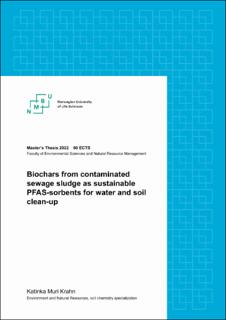| dc.description.abstract | Due to the considerable persistence, mobility, and toxicity of per- and polyfluoroalkyl substances (PFAS), techniques for the remediation of soil and water contaminated with PFAS are urgently needed. The potential for using various lightly contaminated organic waste materials in the production of biochar sorbents for PFAS has sparked great interest among researchers. Biochar also represents one of the most promising technologies for carbon sequestration.
This study sought to test if biochar produced from sewage sludge can function equally effectively in sorbing PFAS as biochar produced from a clean wood-based feedstock (CWC) and activated carbons tested in earlier studies. The sewage sludge feedstocks tested were Ullensaker sludge (ULS) which contains PFAS-enriched wastewater, and digested sludge (DSL), the fraction remaining from anaerobic digestion of waste organic matter. A series of batch tests were prepared for each biochar. These were spiked with six perfluorinated carboxylic acids (PFCA) with 5 to 10 perfluorinated carbons at different concentrations. To measure sorption attenuation--the sorption suppression effect that occurs in more complex systems where natural organic matter found in soil can block biochar pores, and where other compounds compete for a limited number of sorption sites---both single-compound experiments and a cocktail of different PFCAs added to sandy soil (1.3% TOC) with and without biochar, were tested. Biochar-water and soil-biochar-water isotherms were generated from the batch tests. Using pore size distributions determined by CO2 and N2 sorptometry for pores 0.4-1.5 nm and larger than 1.5 nm respectively, surface area and pore volumes were evaluated in terms of their effects on PFCA sorption. The effects of carbon, calcium and iron content on PFCA sorption were also evaluated.
In all batch tests, the sewage sludge biochars turned out to be stronger sorbents for PFCA than CWC biochar. Differences in sorption between the CWC, DSL, and ULS biochars were explained by three main findings: 1) the majority of pores in CWC were too small (<0.6 nm) to accommodate PFCAs, whose maximum molecular dimensions range from 0.96-1.54 nm, 2) CWC had a much lower pore volume for pore sizes above 1.5 nm than DSL and ULS, limiting the pores' filling capacity, and 3) ULS biochar had higher pore volume, surface area, and carbon-content than DSL biochar. Freundlich partition coefficients (log K_F) in (μg/kg)/(μg/L)^n} were highest for the batch tests with biochar and singly spiked PFCAs. For PFDA, log K_Fs were 6.00 ± 0.04, 5.61 ± 0.02, and 5.22 ± 0.07 for ULS, DSL, and CWC biochars respectively. Sorption was positively correlated with increasing perfluorinated chain length. Chain length dependency on sorption indicated that hydrophobic interactions are likely the dominant sorption mechanisms over electrostatic interactions between biochar and PFAS. Sorption was attenuated by factors of 6-140 in the presence of a PFCA cocktail, 8-138 in the presence of soil and a PFCA cocktail for PFOA, PFNA, and PFDA, and 3-10 for PFOA in the presence of soil.
One of this study's limitations is that its conclusions were drawn based on no more than three biochar samples. To corroborate the findings in this study, further research based on testing a larger sample size is needed.
The high sorption strength of sewage sludge biochars found in this study shows great promise for developing new, sustainable, and cost-effective toxic waste management methods. Converting contaminated wastes that are costly to dispose of properly into commercial sorbents is an important contribution to a circular economy, and one that simultaneously addresses the urgent need for increased carbon sequestration. | en_US |
| dc.description.abstract | Grunnet per- og polyfluoralkylsubstansers (PFAS) betydelige persistens, mobilitet og toksisitet, er teknikker for remediering av jord og vann forurenset med PFAS høyst nødvendig. Potensialet for å bruke ulike lettforurensede organiske avfallsmaterialer til produksjon av biokullsorbenter for PFAS har vakt stor interesse blant forskere. Biokull representerer også en av de mest lovende teknologiene for karbonbinding.
Denne studien forsøkte å teste om biokull produsert fra kloakkslam kan fungere like effektivt til sorpsjon av PFAS som biokull produsert fra et rent, trebasert materiale (CWC), og aktivert karbon som har blitt testet i tidligere studier. Avløpsslammene som ble testet var Ullensakerslam (ULS) som inneholder avlopsvann anriket med PFAS, og slam fra biorest (DSL), fraksjonen som gjenstår fra anaerob nedbryting av organisk avfall. En serie med ristetester ble utført for hvert biokull. Disse ble tilsatt seks perfluorerte karboksylsyrer (PFCA) med 5 til 10 perfluorerte karboner ved økende konsentrasjoner. Demping er den sorpsjonsdempende effekten som oppstår i mer komplekse systemer der naturlig organisk materiale som finnes i jord kan blokkere porene til biokull, og hvor andre forbindelser konkurrerer om et begrenset antall sorpsjonsseter. For å måle demping ble både forsøk med enkeltforbindelser og en cocktail av forskjellige PFCA tilsatt sandig jord (1,3% TOC) med og uten biokull utført. Biokull-vann og jord-biokull-vannisotermer ble generert fra ristetestene. Vedå bruke porestørrelsesfordelingene bestemt av CO2- og N2-sorptometri for henholdsvis porer mellom 0,4-1,5 nm og porer større enn 1,5 nm, ble sammenhengen mellom størrelsen på overflatearealene og porevolumene, og biokullenes evne til sorpsjon av PFCA vurdert mot hverandre. Effektene av karboninnhold, kalsium og jern for PFCA-sorpsjon ble også evaluert. | en_US |

